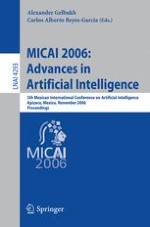Artificial Intelligence embraces heuristic methods of solving complex problems for which exact algorithmic solutions are not known. Among them are, on the one hand, tasks related to modeling of human intellectual activity such as thinking, learning, seeing, and speaking, and on the other hand, super-complex optimization problems appearing in science, social life, and industry. Many methods of Artificial Intelligence are borrowed from nature where similar super-complex problems occur. This year is special for the Artificial Intelligence community. This year we th celebrate the 50 anniversary of the very term “Artificial Intelligence”, which was first coined in 1956. This year is also very special for the Artificial Intelligence th community in Mexico: it is the 20 anniversary of the Mexican Society for Artificial Intelligence, SMIA, which organizes the MICAI conference series. The series itself also celebrates its own round figure: the fifth event. We can now see that MICAI has reached its maturity, having grown dramatically in size and quality, see Figs. 1 to 3. The proceedings of the previous MICAI events were also published in Springer’s Lecture Notes in Artificial Intelligence (LNAI) series, in volumes 1793, 2313, 2972, and 3789. th This volume contains the papers presented during the oral session of the 5 Mexican International Conference on Artificial Intelligence, held on November 13–17, 2006, at the Technologic Institute of Apizaco, Mexico. The conference received for evaluation 448 submissions by 1207 authors from 42 different countries, see Tables 1 and 2.
